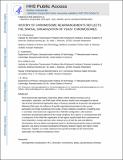History of chromosome rearrangements reflects the spatial organization of yeast chromosomes
Author(s)
Khrameeva, Ekaterina E.; Gelfand, Mikhail S.; Fudenberg, Geoffrey; Mirny, Leonid A
Downloadnihms786770.pdf (222.2Kb)
OPEN_ACCESS_POLICY
Open Access Policy
Creative Commons Attribution-Noncommercial-Share Alike
Terms of use
Metadata
Show full item recordAbstract
Three-dimensional (3D) organization of genomes affects critical cellular processes such as transcription, replication, and deoxyribo nucleic acid (DNA) repair. While previous studies have investigated the natural role, the 3D organization plays in limiting a possible set of genomic rearrangements following DNA repair, the influence of specific organizational principles on this process, particularly over longer evolutionary time scales, remains relatively unexplored. In budding yeast S.cerevisiae, chromosomes are organized into a Rabl-like configuration, with clustered centromeres and telomeres tethered to the nuclear periphery. Hi-C data for S.cerevisiae show that a consequence of this Rabl-like organization is that regions equally distant from centromeres are more frequently in contact with each other, between arms of both the same and different chromosomes. Here, we detect rearrangement events in Saccharomyces species using an automatic approach, and observe increased rearrangement frequency between regions with higher contact frequencies. Together, our results underscore how specific principles of 3D chromosomal organization can influence evolutionary events.
Date issued
2016-03Department
Massachusetts Institute of Technology. Department of PhysicsJournal
Journal of Bioinformatics and Computational Biology
Publisher
World Scientific Publishing
Citation
Khrameeva, Ekaterina E. et al. “History of Chromosome Rearrangements Reflects the Spatial Organization of Yeast Chromosomes.” Journal of Bioinformatics and Computational Biology 14, 2 (April 2016): 1641002 © 2016 World Scientific Publishing
Version: Author's final manuscript
ISSN
0219-7200
1757-6334